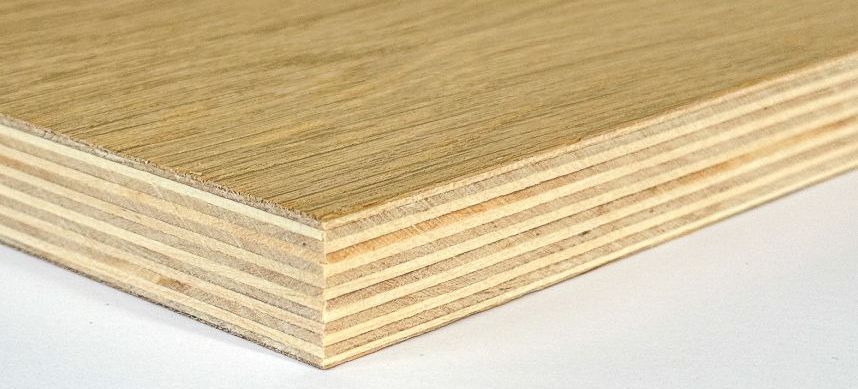Veneered Plywood Panels

Introduction
Veneering involves applying a thin layer of high-quality wood onto a more affordable or commercially available core. Veneered MDF and chipboard are popular materials for furniture, cabinet making and shopfitting. Veneered plywood is a little more specialist and is favoured when the laminated edge will be used as a design feature, or when the panel requires more strength than MDF or chipboard can provide.
Why Veneer Plywood?
High quality plywood has a well made core construction that is carefully manufactured to reduce core gaps and overlaps. If veneered plywood is chosen to also show the core, then only a few types of plywood panels are suitable for this use. We would recommend birch plywood, poplar plywood or European pine plywood as having decent enough cores to show as part of the design. The shortcomings is that commercially made high quality plywood is limited to only a few species and, therefore, colour tones. This is why applying veneers to plywood is required if you want a different species on the face. Oak plywood, Ash plywood, Walnut plywood, Cherry plywood etc. are not manufactured with the same species throughout, as it would be too expensive and the volume of logs are simply not available. Therefore using veneers will be the only way to achieve an oak faced plywood, walnut faced plywood, ash faced plywood etc.
Can you Veneer onto Plywood?
Yes, plywood is a good core material to use for veneered panels and is available from 4mm to 40mm thickness. Plywood must be veneered both sides to equalise the panel tension and help improve dimensional stability. The same principal applies when bonding laminates or phenol films to plywood, the reverse is always "balanced." Plywood is generally stable and will resist shrinkage or expansion. High-grade plywood with smoother surfaces and fewer imperfections provides the best base for veneers. Any plywood with open defects / knot holes would not be suitable. During the manufacture of birch plywood, physical defects are replaced with plugs or patches and so there are no issues veneering onto birch plywood that has a BB face grade. The same principal applies to our European pine plywood. Poplar plywood faces are defect free with usually no plugs / patches required. This is due to poplar logs being larger and the peeled core yields a lot of clean plies, compared to birch or pine.
What are the Benefits of Veneered Plywood?
Plywood is much stronger than MDF or Chipboard and should be specified where strength is an important factor. Applications would be wall lining of a gymnasium, where impact from tennis balls / cricket balls is a consideration. Commercial furniture or shopfitting furniture can be subjected to a lot of hard use or impacts that may damage the panels. Veneered plywood would be a stronger option.
Plywood is generally supplied with an exterior glue line and so can resist moisture far better than some other core materials. Whilst we would not suggest using decorative veneered plywood panels in applications where water contact is likely, should an accident happen the plywood core will easily cope with getting wet. MDF or chipboard will swell and expand and would not be as durable.
Showing the Plywood Core on Veneered Panels
Increasingly, using the plywood core itself as a design feature is becoming more and more popular. The sight of a plywood core is a sign of quality and strength and elevates the project. It adds a more natural look as it removes the requirement for a plastic edge strip. Edges may need to be stained so the core more closely resembles the colour of the veneered faces. A correctly stained core with a good colour match to the faces would create the impression of a oak throughout plywood panel. All the plywood types we use would accept a stain and as they are generally light in colour, they can easily be stained darker to match the face veneers. This is not applicable to lighter veneer species such as ash, maple, sycamore, birch or white beech - as the core will already be a close match.
Panel Sizes
Plywood is most often produced in the popular size: 2440mm x 1220mm (8ft x 4ft)
Birch plywood is perhaps the most versatile plywood and is available in a number of press sizes from the European mills, including 1525 x 3050mm (5ft x 10ft).
Some plywood is only manufactured in 2440 x 1220, such as douglas fir plywood and European pine plywood . The only way to achieve a larger panel size than 8ft tall with these species, would be to veneer a 10ft birch plywood core with a pine or douglas fir veneer.
Of course, MDF or chipboard is available in larger sizes and can also be offered.
Conclusion
Plywood is an excellent panel to veneer onto. The decorative edges, the strength and the durability all combine to create a well-suited base board. As veneered plywood UK suppliers, we are here to answer any questions you may have and look forward to working with you on your next project.
Please get in touch for a quote or for more information: 01992 410333 or panels@spp.co.uk
